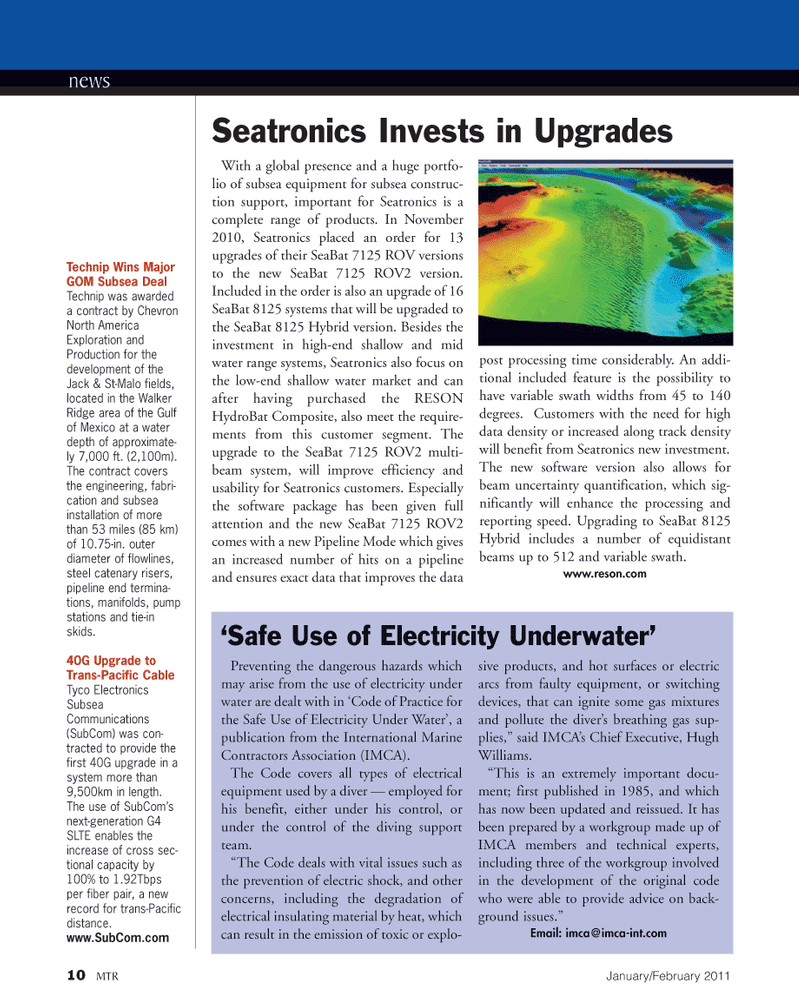
Page 10: of Marine Technology Magazine (January 2011)
Marine Salvage & Recovery
Read this page in Pdf, Flash or Html5 edition of January 2011 Marine Technology Magazine
news 10 MTR January/February 2011
Technip Wins Major
GOM Subsea Deal
Technip was awarded a contract by Chevron
North America
Exploration and
Production for the development of the
Jack & St-Malo fields, located in the Walker
Ridge area of the Gulf of Mexico at a water depth of approximate- ly 7,000 ft. (2,100m).
The contract covers the engineering, fabri- cation and subsea installation of more than 53 miles (85 km) of 10.75-in. outer diameter of flowlines, steel catenary risers, pipeline end termina- tions, manifolds, pump stations and tie-in skids. 40G Upgrade to
Trans-Pacific Cable
Tyco Electronics
Subsea
Communications (SubCom) was con- tracted to provide the first 40G upgrade in a system more than 9,500km in length.
The use of SubCom’s next-generation G4
SLTE enables the increase of cross sec- tional capacity by 100% to 1.92Tbps per fiber pair, a new record for trans-Pacific distance. www.SubCom.com
With a global presence and a huge portfo- lio of subsea equipment for subsea construc- tion support, important for Seatronics is a complete range of products. In November 2010, Seatronics placed an order for 13 upgrades of their SeaBat 7125 ROV versions to the new SeaBat 7125 ROV2 version.
Included in the order is also an upgrade of 16
SeaBat 8125 systems that will be upgraded to the SeaBat 8125 Hybrid version. Besides the investment in high-end shallow and mid water range systems, Seatronics also focus on the low-end shallow water market and can after having purchased the RESON
HydroBat Composite, also meet the require- ments from this customer segment. The upgrade to the SeaBat 7125 ROV2 multi- beam system, will improve efficiency and usability for Seatronics customers. Especially the software package has been given full attention and the new SeaBat 7125 ROV2 comes with a new Pipeline Mode which gives an increased number of hits on a pipeline and ensures exact data that improves the data post processing time considerably. An addi- tional included feature is the possibility to have variable swath widths from 45 to 140 degrees. Customers with the need for high data density or increased along track density will benefit from Seatronics new investment.
The new software version also allows for beam uncertainty quantification, which sig- nificantly will enhance the processing and reporting speed. Upgrading to SeaBat 8125
Hybrid includes a number of equidistant beams up to 512 and variable swath. www.reson.com
Seatronics Invests in Upgrades
Preventing the dangerous hazards which may arise from the use of electricity under water are dealt with in ‘Code of Practice for the Safe Use of Electricity Under Water’, a publication from the International Marine
Contractors Association (IMCA).
The Code covers all types of electrical equipment used by a diver — employed for his benefit, either under his control, or under the control of the diving support team. “The Code deals with vital issues such as the prevention of electric shock, and other concerns, including the degradation of electrical insulating material by heat, which can result in the emission of toxic or explo- sive products, and hot surfaces or electric arcs from faulty equipment, or switching devices, that can ignite some gas mixtures and pollute the diver’s breathing gas sup- plies,” said IMCA’s Chief Executive, Hugh
Williams. “This is an extremely important docu- ment; first published in 1985, and which has now been updated and reissued. It has been prepared by a workgroup made up of
IMCA members and technical experts, including three of the workgroup involved in the development of the original code who were able to provide advice on back- ground issues.”
Email: imca@ imca-int.com ‘Safe Use of Electricity Underwater’

 9
9

 11
11
